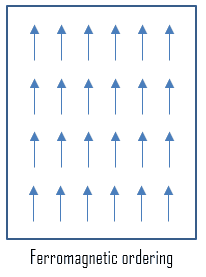Magnetic property refers to the response of a material to an applied magnetic field. The macroscopic magnetic properties of a material are a consequence of interactions between an external magnetic field and the magnetic dipole moments of the constituent atoms. Different materials react to the application of magnetic fields differently. The most familiar effects occur in ferromagnetic materials, which are strongly attracted by magnetic fields and can be magnetized to become permanent magnets, producing magnetic fields. Only a few substances are ferromagnetic; the most common ones are iron, cobalt, and nickel and their alloys.
Ferromagnetic Material – Ferromagnetism
 Ferromagnetism is the basic mechanism by which material forms a permanent magnet (i.e., materials that can be magnetized by an external magnetic field and remain magnetized after the external field is removed). Ferromagnetism is the strongest type and is responsible for this common phenomenon. Ferromagnetic, ferrimagnetic, or antiferromagnetic materials possess permanent magnetization without an external magnetic field and do not have a well-defined zero-field susceptibility. Permanent magnetic moments in ferromagnetic materials result from atomic magnetic moments due to unpaired electron spins due to the electron structure. There is also a small orbital magnetic moment contribution compared to the spin moment. Thus, even in the absence of an applied field, the magnetic moments of the electrons in the material spontaneously line up parallel to one another. Every ferromagnetic material has its temperature, called the Curie temperature, or Curie point, above which it loses its ferromagnetic properties. This is because the thermal tendency to disorder overwhelms the energy-lowering due to ferromagnetic order. Only a few substances are ferromagnetic. The common ones are iron, cobalt, nickel, and most of their alloys, and some compounds of rare earth metals. Ferromagnetism is very important in industry and modern technology. Ferromagnetic materials can be divided into magnetically “soft” materials like annealed iron, which can be magnetized but does not tend to stay magnetized, and magnetically “hard” materials, which do. Permanent magnets are made from “hard” ferromagnetic materials such as alnico and ferrite that are subjected to special processing in a strong magnetic field during manufacture to align their internal microcrystalline structure, making them very hard to demagnetize.
Ferromagnetism is the basic mechanism by which material forms a permanent magnet (i.e., materials that can be magnetized by an external magnetic field and remain magnetized after the external field is removed). Ferromagnetism is the strongest type and is responsible for this common phenomenon. Ferromagnetic, ferrimagnetic, or antiferromagnetic materials possess permanent magnetization without an external magnetic field and do not have a well-defined zero-field susceptibility. Permanent magnetic moments in ferromagnetic materials result from atomic magnetic moments due to unpaired electron spins due to the electron structure. There is also a small orbital magnetic moment contribution compared to the spin moment. Thus, even in the absence of an applied field, the magnetic moments of the electrons in the material spontaneously line up parallel to one another. Every ferromagnetic material has its temperature, called the Curie temperature, or Curie point, above which it loses its ferromagnetic properties. This is because the thermal tendency to disorder overwhelms the energy-lowering due to ferromagnetic order. Only a few substances are ferromagnetic. The common ones are iron, cobalt, nickel, and most of their alloys, and some compounds of rare earth metals. Ferromagnetism is very important in industry and modern technology. Ferromagnetic materials can be divided into magnetically “soft” materials like annealed iron, which can be magnetized but does not tend to stay magnetized, and magnetically “hard” materials, which do. Permanent magnets are made from “hard” ferromagnetic materials such as alnico and ferrite that are subjected to special processing in a strong magnetic field during manufacture to align their internal microcrystalline structure, making them very hard to demagnetize.